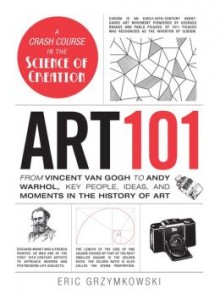Posted February 28, 2014
“Art 101: A Course in the Science of Creation”
By Eric Grymkowski
By VALERIE LOPEZ
A book dedicated to show the beauty of fine art by getting rid of the complex vocabulary, boring discourses and lengthy explanations that ends up explaining nothing and confusing more is what “Art 101: A Course in the Science of Creation,” by Eric Grymkowski, tried to achieve without succeeding.
 The author embarks into the complex and ambitious task of explaining art history. He begins by giving a brief explanation of the color theory that evolved into the temperature of colors.
The author embarks into the complex and ambitious task of explaining art history. He begins by giving a brief explanation of the color theory that evolved into the temperature of colors.
This concept continued into art in 1919 with Bauhaus’ use of art and design into daily life and with the description of art as a form of therapy, for example for depression patients.
Grymkowski is a humor writer from Somerville, Mass. He is a freelance writer at Adams Media, which probably explains why he wrote the book.
Grymkowski does a pretty decent job summarizing the most important movements and artist yet he failed by not organizing the book chronologically. It’s understandable that the author wasn’t after a “boring art book,” but not having a chronological order in the matters of art history is vital for its understanding because one movement led to the other.
There is no point in explaining Dadaism first than Romanticism or Expressionism. Dadaism was a rebellion against traditional paintings and what could be called or used as art. There is also no reason to talk about cave painting at the end of the book and later explain the Mona Lisa.
Grymkowski explains in the introduction that art books assume that readers should know complex terminology and concepts and what he was tried to achieve was to teach readers about art with having to follow an order, yet how can you not follow and order when art movements are a cause and effect of one another? Instead of clarifying the history of art he created a turmoil between movements and artists.
Aside from jumping from one movement to the next, the brief summaries of each art era were described accurately with the intent to clarify their needs, characteristic and most important artist or artists of the moment. It was refreshing to read concisely about this.
The book highlights the most prominent painters and photographers throughout art history, such as Man Ray, Claude Monet, Ansel Adams and Jackson Pollock, but due to its brevity left many others behind.
Grymkowski failed again by not having any illustrations, drawings or visual examples of the art movements. The author only emphases in its description not giving the reader a visual reference of the art, this aspect is also crucial for the understanding of art history. Only after 128 pages, the author finally added three pages of pictures about Diego Rivera, a Mexican muralist that influenced what is now known as street art.
A plus for the book is the fact that it tried to find a connection between the art movements of the past to what art is today by giving importance to the concept of “the world as a gallery.” Talking about artists like Banksy show that the author is familiar with the evolution art has gone through the past century.
The book’s brief explanation of art history is not meant for readers that have no knowledge in art movements because they will find themselves confused without a chronological order and will have no visual reference to the art itself. However, it is a refreshing read that works as a good reference that synthesizes the history of art for advanced art connoisseurs.
- Title: “Art 101: A Course in the Science of Creation”
- Author: Eric Grymkowski
- Pages: 288 pp.
- Publisher: Adams Media
- Price: $15.99
- Release date: December 2013
- Rating: ***
